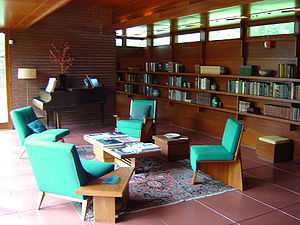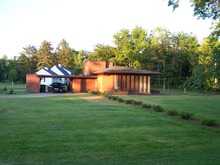Usonia

Usonia /juːˈsoʊniə/ was a word used by American architect Frank Lloyd Wright to refer to his vision for the landscape of the United States, including the planning of cities and the architecture of buildings. Wright proposed the use of the adjective Usonian in place of American to describe the particular New World character of the American landscape as distinct and free of previous architectural conventions.
Usonian houses
'Usonian' is a term usually referring to a group of approximately sixty middle-income family homes designed by Frank Lloyd Wright beginning in 1936 with the Jacobs House.[1] The "Usonian Homes" were typically small, single-story dwellings without a garage or much storage. They were often L-shaped to fit around a garden terrace on unusual and inexpensive sites. Constructed with native materials, flat roofs and large cantilevered overhangs for passive solar heating and natural cooling, natural lighting with clerestory windows, and radiant-floor heating. A strong visual connection between the interior and exterior spaces is an important characteristic of all Usonian homes. The word carport was coined by Wright to describe an overhang for sheltering a parked vehicle.
Variants of the Jacobs House design are still in existence today. The Usonian design is considered among the aesthetic origins of the ranch-style house popular in the American west of the 1950s.
In 2013, Florida Southern College constructed the 13th Wright building on their campus according to plans that he created in 1939. The 1,700 sq. ft. building includes textile-block construction, colored glass in perforated concrete blocks, Wright photographs, a documentary film about the architect's work at the school, and furniture designed by Wright. Named the "Usonian House," it was originally designed as one of twenty faculty housing units. The building is home to the Sharp Family Tourism and Education Center, a visitor center for guests visiting campus to see the collection of Frank Lloyd Wright buildings. [2]
Origin of the word
The word Usonian appears to have been coined by James Duff Law, an American writer born in 1865. In a miscellaneous collection entitled, Here and There in Two Hemispheres (1903), Law quoted a letter of his own (dated June 18, 1903) that begins "We of the United States, in justice to Canadians and Mexicans, have no right to use the title 'Americans' when referring to matters pertaining exclusively to ourselves." He went on to acknowledge that some author had proposed "Usona", but that he preferred the form "Usonia".[3] Perhaps the earliest published use by Wright was in 1927:
But why this term "America" has become representative as the name of these United States at home and abroad is past recall. Samuel Butler fitted us with a good name. He called us Usonians, and our Nation of combined States, Usonia.
- –Frank Lloyd Wright on Architecture: Selected Writings 1894–1940, p. 100.
However, this is a misattribution, as Butler never used the word.
It has become the established name for the United States in Esperanto.[4] The creator of Esperanto, L. L. Zamenhof, used Usono in his speech at the 1910 World Congress of Esperanto in Washington, D.C., coincidentally the same year Wright was in Europe.
José F. Buscaglia-Salgado reclaims the term Usonian to refer to the peoples, national ideology and neo-imperial tradition of the United States of America.[5]
Miguel Torres-Castro uses the term Usonian to refer to the origin of the Atlantic Puffin bird used in the children's book "Jupu the Puffin: A Usonian Story". The bird is a puffin from Maine, USA.[6]
Noted Usonian houses

- John D. Haynes House, Fort Wayne, Indiana
- Goetsch-Winckler House, Okemos, Michigan
- Arthur Pieper residence, Paradise Valley, Arizona
- Bernard Schwartz House, Two Rivers, Wisconsin
- Donald C. Duncan House, Donegal, Pennsylvania (dismantled and relocated from its original location in Lisle, Illinois)
- Dorothy H. Turkel House, Detroit, Michigan
- Frank S. Sander House, Stamford, Connecticut
- Evelyn and Conrad Gordon House, Wilsonville, Oregon (later moved to Silverton, Oregon)
- Herbert and Katherine Jacobs First House, Madison, Wisconsin
- J.A. Sweeton Residence, Cherry Hill, New Jersey
- Kentuck Knob, Stewart Township, Fayette County, Pennsylvania
- Louis Penfield House, Willoughby Hills, Ohio
- Lowell and Agnes Walter House, Quasqueton, Iowa
- Melvyn Maxwell and Sara Stein Smith House, Bloomfield Hills, Michigan
- Muirhead Farmhouse, Hampshire, Illinois
- Paul J. and Ida Trier House, Johnston, Iowa
- Pope-Leighey House, Alexandria, Virginia
- Robert H. Sunday House, Marshalltown, Iowa
- Robert and Rae Levin House, Kalamazoo, Michigan
- Rosenbaum House, Florence, Alabama
- Samara (John E. Christian House), West Lafayette, Indiana
- Usonia Homes, Pleasantville, New York
- Weltzheimer/Johnson House, Oberlin, Ohio
- Zimmerman House, Manchester, New Hampshire
- Kraus House, Kirkwood, Missouri
See also
- Polychrome Historic District, a similar effort to provide inexpensive housing by John Joseph Earley
Notes
- ↑ "Frank Lloyd Wright - The Jacobs House 1936".
- ↑ Wright Stuff March 2014 Florida Trend page 36
- ↑ James D. Law, Here and There in Two Hemispheres (Lancaster: Home Publishing Co., 1903), pp. 111–12n.
- ↑ Wiktionary:Usono
- ↑ Buscaglia-Salgado, José F. (2003). Undoing Empire, Race, and Nation in the Mulatto Caribbean. Minneapolis: University of Minnesota Press. ISBN 0-8166-3574-9.
- ↑ Torres-Castro, Miguel (2014). Jupu the Puffin: A Usonian Story. New York City: Jupu Press. ISBN 0-6159-4073-0.
External links
| Look up Usonian in Wiktionary, the free dictionary. |
- John D. Haynes House
- Jones House
- Jacobs House
- Frank Lloyd Wright: Usonian House at PBS.org
- Columbia University - Usonia: Frank Lloyd Wright's Vision for America
- Pope-Leighey House, Usonian house in Alexandria, Virginia, open to the public
- Weltzheimer/Johnson House, Usonian house in Oberlin, Ohio, open to the public
- , Rosenbaum House Florence Alabama
- List of Usonian houses
- The Post Usonian Project
- Florida Southern College
| ||||||||||||||||||||||||||||||
